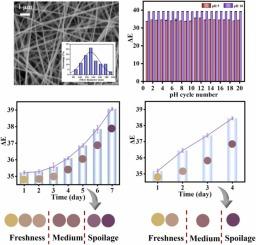A reversible color switching nano-sensing label based on polyvinyl alcohol-acidochromic chitosan (PVA-ACS) for enhanced recognition of meat freshness
IF 3.7
1区 化学
Q1 CHEMISTRY, ANALYTICAL
引用次数: 0
Abstract
In this work, an intelligent and sensitive polyvinyl alcohol-acidochromic chitosan (PVA-ACS) nano-sensing label was developed for visually monitoring meat freshness. Based on the synthesis of 1-hydroxy-4-[4-(ethylsulfurate sulfonyl)-phenylazo]-naphthalene (HESPN), ACS was prepared through hydrogen bonding between the sulfonic acid groups in HESPN structure and the hydroxyl groups in chitosan (CS). Herein, PVA was used as the functional matrix and electrospinning technology was employed in this process. The chemical structure, surface morphology, mechanical properties, hydrophilicity, thermal stability, and biocompatibility of PVA-ACS nano-sensing label were investigated. Moreover, the PVA-ACS nano-sensing label exhibited sensitive color responsiveness and reversible color switching, and the properties enabled the naked-eye inspection of meat freshness during production, processing and transportation. Furthermore, a strategy incorporated the nano-sensing labels with a smartphone was developed to record color information in conjunction with the color recognition software (ColorColl). This work provided a valuable perspective for real-time freshness monitoring with high satisfaction and efficiency, opening new possibilities for meat quality grading.

一种基于聚乙烯醇-酸致变色壳聚糖(PVA-ACS)的可逆变色纳米传感标签,用于增强肉类新鲜度的识别
本文研制了一种智能灵敏的聚乙烯醇-酸致变色壳聚糖(PVA-ACS)纳米传感标签,用于肉类新鲜度的视觉监测。在合成1-羟基-4-[4-(硫酸乙酯磺酰基)-苯偶氮]-萘(HESPN)的基础上,通过HESPN结构中的磺酸基与壳聚糖(CS)中的羟基之间的氢键反应制备了ACS。本文以聚乙烯醇(PVA)为功能基体,采用静电纺丝技术。研究了PVA-ACS纳米传感标签的化学结构、表面形貌、力学性能、亲水性、热稳定性和生物相容性。此外,PVA-ACS纳米传感标签具有灵敏的颜色响应性和可逆的颜色切换特性,可以在生产、加工和运输过程中对肉类的新鲜度进行肉眼检测。此外,还开发了一种将纳米传感标签与智能手机结合的策略,以与颜色识别软件(ColorColl)一起记录颜色信息。这项工作为高满意度和高效率的实时新鲜度监测提供了有价值的视角,为肉类品质分级开辟了新的可能性。
本文章由计算机程序翻译,如有差异,请以英文原文为准。
求助全文
约1分钟内获得全文
求助全文
来源期刊

Sensors and Actuators B: Chemical
工程技术-电化学
CiteScore
14.60
自引率
11.90%
发文量
1776
审稿时长
3.2 months
期刊介绍:
Sensors & Actuators, B: Chemical is an international journal focused on the research and development of chemical transducers. It covers chemical sensors and biosensors, chemical actuators, and analytical microsystems. The journal is interdisciplinary, aiming to publish original works showcasing substantial advancements beyond the current state of the art in these fields, with practical applicability to solving meaningful analytical problems. Review articles are accepted by invitation from an Editor of the journal.
 求助内容:
求助内容: 应助结果提醒方式:
应助结果提醒方式:


